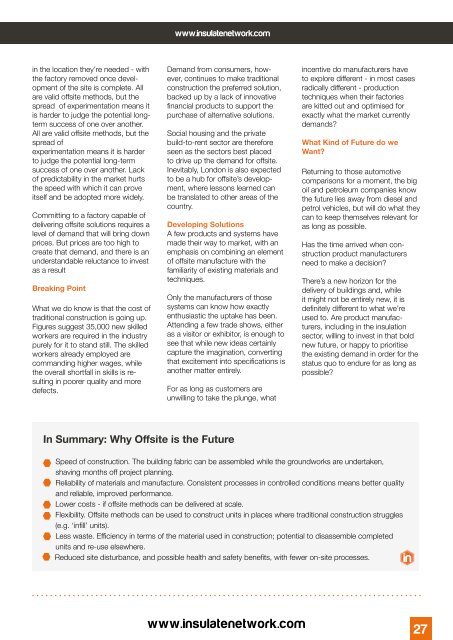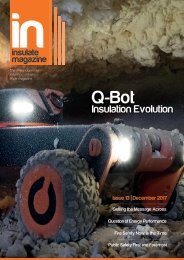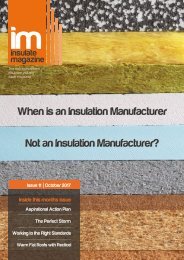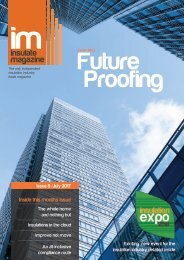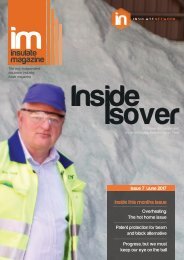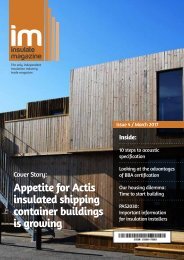Insulate Magazine Issue 15
You also want an ePaper? Increase the reach of your titles
YUMPU automatically turns print PDFs into web optimized ePapers that Google loves.
www.insulatenetwork.com<br />
in the location they’re needed - with<br />
the factory removed once development<br />
of the site is complete. All<br />
are valid offsite methods, but the<br />
spread of experimentation means it<br />
is harder to judge the potential longterm<br />
success of one over another.<br />
All are valid offsite methods, but the<br />
spread of<br />
experimentation means it is harder<br />
to judge the potential long-term<br />
success of one over another. Lack<br />
of predictability in the market hurts<br />
the speed with which it can prove<br />
itself and be adopted more widely.<br />
Committing to a factory capable of<br />
delivering offsite solutions requires a<br />
level of demand that will bring down<br />
prices. But prices are too high to<br />
create that demand, and there is an<br />
understandable reluctance to invest<br />
as a result<br />
Breaking Point<br />
What we do know is that the cost of<br />
traditional construction is going up.<br />
Figures suggest 35,000 new skilled<br />
workers are required in the industry<br />
purely for it to stand still. The skilled<br />
workers already employed are<br />
commanding higher wages, while<br />
the overall shortfall in skills is resulting<br />
in poorer quality and more<br />
defects.<br />
Demand from consumers, however,<br />
continues to make traditional<br />
construction the preferred solution,<br />
backed up by a lack of innovative<br />
financial products to support the<br />
purchase of alternative solutions.<br />
Social housing and the private<br />
build-to-rent sector are therefore<br />
seen as the sectors best placed<br />
to drive up the demand for offsite.<br />
Inevitably, London is also expected<br />
to be a hub for offsite’s development,<br />
where lessons learned can<br />
be translated to other areas of the<br />
country.<br />
Developing Solutions<br />
A few products and systems have<br />
made their way to market, with an<br />
emphasis on combining an element<br />
of offsite manufacture with the<br />
familiarity of existing materials and<br />
techniques.<br />
Only the manufacturers of those<br />
systems can know how exactly<br />
enthusiastic the uptake has been.<br />
Attending a few trade shows, either<br />
as a visitor or exhibitor, is enough to<br />
see that while new ideas certainly<br />
capture the imagination, converting<br />
that excitement into specifications is<br />
another matter entirely.<br />
For as long as customers are<br />
unwilling to take the plunge, what<br />
incentive do manufacturers have<br />
to explore different - in most cases<br />
radically different - production<br />
techniques when their factories<br />
are kitted out and optimised for<br />
exactly what the market currently<br />
demands?<br />
What Kind of Future do we<br />
Want?<br />
Returning to those automotive<br />
comparisons for a moment, the big<br />
oil and petroleum companies know<br />
the future lies away from diesel and<br />
petrol vehicles, but will do what they<br />
can to keep themselves relevant for<br />
as long as possible.<br />
Has the time arrived when construction<br />
product manufacturers<br />
need to make a decision?<br />
There’s a new horizon for the<br />
delivery of buildings and, while<br />
it might not be entirely new, it is<br />
definitely different to what we’re<br />
used to. Are product manufacturers,<br />
including in the insulation<br />
sector, willing to invest in that bold<br />
new future, or happy to prioritise<br />
the existing demand in order for the<br />
status quo to endure for as long as<br />
possible?<br />
In Summary: Why Offsite is the Future<br />
Speed of construction. The building fabric can be assembled while the groundworks are undertaken,<br />
shaving months off project planning.<br />
Reliability of materials and manufacture. Consistent processes in controlled conditions means better quality<br />
and reliable, improved performance.<br />
Lower costs - if offsite methods can be delivered at scale.<br />
Flexibility. Offsite methods can be used to construct units in places where traditional construction struggles<br />
(e.g. ‘infill’ units).<br />
Less waste. Efficiency in terms of the material used in construction; potential to disassemble completed<br />
units and re-use elsewhere.<br />
Reduced site disturbance, and possible health and safety benefits, with fewer on-site processes.<br />
www.insulatenetwork.com<br />
27


